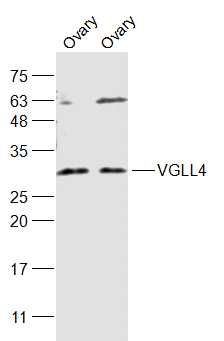产品货号 : mlR9185
英文名称 : VGLL4
中文名称 : 转录辅助因子退变样蛋白4抗体
别 名 : Transcription cofactor vestigial like protein 4; Vestigial like protein 4; VGL 4; VGLL4; VGLL4_HUMAN.
研究领域 : 细胞生物
抗体来源 : Rabbit
克隆类型 : Polyclonal
交叉反应 : Human, Mouse, Rat, Chicken, Dog, Pig, Cow, Horse, Rabbit, Sheep,
产品应用 : WB=1:500-2000 ELISA=1:500-1000
not yet tested in other applications.
optimal dilutions/concentrations should be determined by the end user.
分 子 量 : 31kDa
细胞定位 : 细胞核
性 状 : Lyophilized or Liquid
浓 度 : 1mg/ml
免 疫 原 : KLH conjugated synthetic peptide derived from human VGLL4:201-290/290
亚 型 : IgG
纯化方法 : affinity purified by Protein A
储 存 液 : 0.01M TBS(pH7.4) with 1% BSA, 0.03% Proclin300 and 50% Glycerol.
保存条件 : Store at -20 癈 for one year. Avoid repeated freeze/thaw cycles. The lyophilized antibody is stable at room temperature for at least one month and for greater than a year when kept at -20癈. When reconstituted in sterile pH 7.4 0.01M PBS or diluent of antibody the antibody is stable for at least two weeks at 2-4 癈.
PubMed : PubMed
产品介绍 : The transcriptional enhancer factor-1 (TEF-1) family of transcription factors regulate tissue-specific gene expression in muscle and placenta. The mechanism whereby TEF-1 confers tissue specificity depends largely on the interaction of TEF-1 with tissue-specific cofactors. Transcription cofactor Vgl-4 (vestigial-like protein 4) is a 290 amino acid nuclear protein that interacts with TEF-1 and MEF-2. Vgl-4 is the only member of the vestigial-like family that is expressed in heart. Overexpression of Vgl-4 in cardiac myocytes interferes with basal expression and ?-adrenergic receptor-dependent activation of a TEF-1 dependent skeletal ?actin promoter. This suggests that Vgl-4 counteracts ?-adrenergic activation of gene expression in cardiomyocytes. There are two isoforms of Vgl-4 that are produced as a result of alternative splicing events.
Function:
May act as a specific coactivator for the mammalian TEFs (By similarity).
Subunit:
Interacts with TEFs (By similarity). Interacts with IRF2BP2.
Subcellular Location:
Nuclear
Similarity:
Belongs to the vestigial family.
SWISS:
Q14135
Gene ID:
9686
Important Note:
This product as supplied is intended for research use only, not for use in human, therapeutic or diagnostic applications.
产品图片












